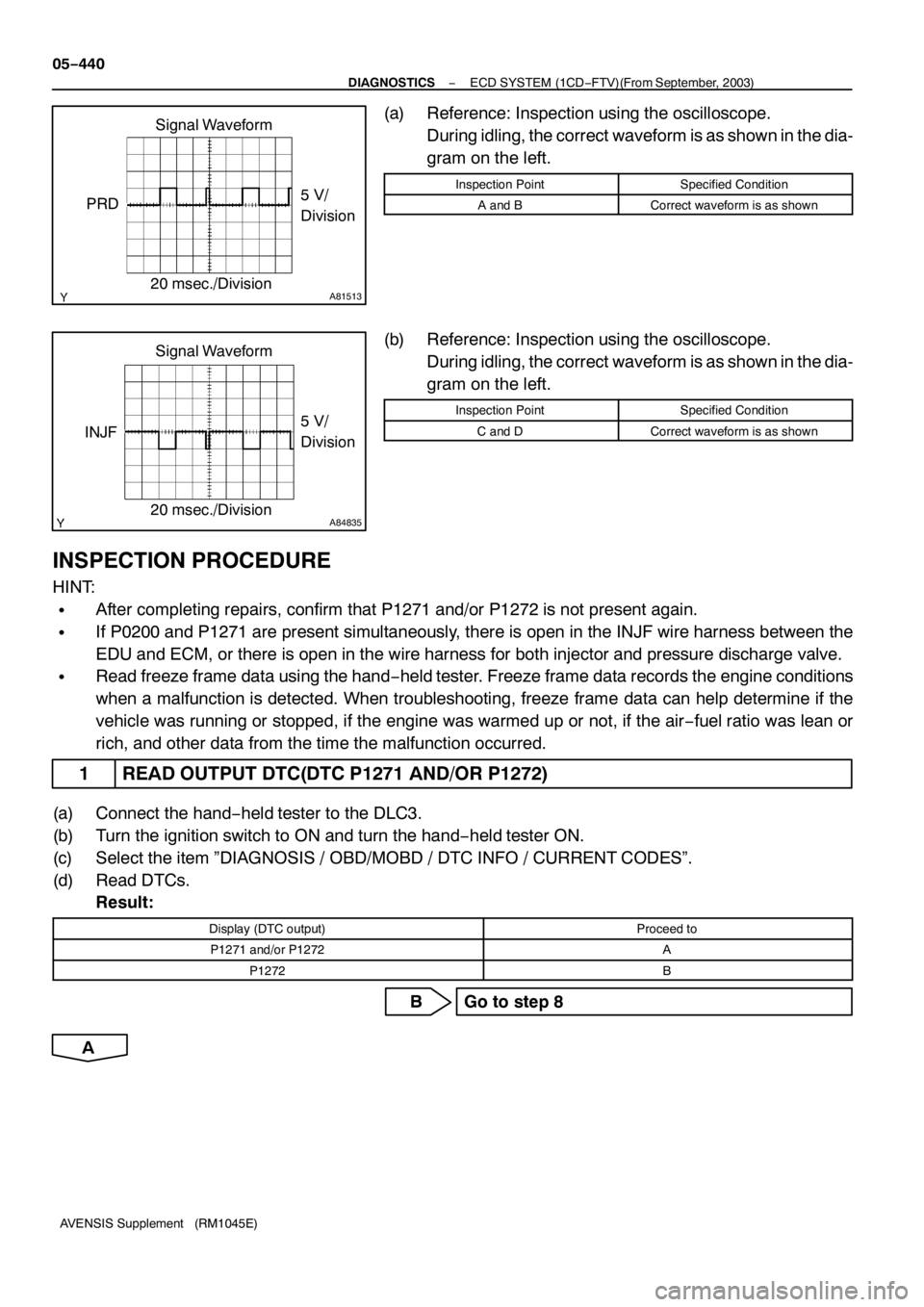TOYOTA AVENSIS 2005 Service Repair Manual
Manufacturer: TOYOTA, Model Year: 2005, Model line: AVENSIS, Model: TOYOTA AVENSIS 2005Pages: 5135, PDF Size: 95.28 MB
Page 4411 of 5135

− DIAGNOSTICSECD SYSTEM (1CD−FTV)(From September, 2003)
05−453
AVENSIS Supplement (RM1045E)
11READ VALUE OF HAND−HELD TESTER(COMPENSATION OF INJECTION
VOLUME FOR EACH CYLINDER)
(a) Connect the hand−held tester to the DLC3.
(b) Turn the ignition switch to ON and turn the hand−held tester ON.
(c) Start the engine.
(d) Select the item ”DIAGNOSIS / OBD/MOBD / DATA LIST / ALL / INJ VOLUME FB” and read its value
displayed on the hand−held tester.
Result:
ResultProceed to
Compensatory Injection Volume is more than 3.0 mm3A
Compensatory Injection Volume is 3.0 mm3or lessB
HINT:
Usually compensation injection volume is 3.0 mm
3or less.
B Go to step13
A
12 CHECK ENGINE COMPONENTS PARTS
(a) Check that there is no abnormality in the main injector, cylinder compression pressure, valve timing
and valve clearance.
(b) Check that there is no leakage or blockage in the air intake, exhaust and EGR systems.
NG REPAIR OR REPLACE
OK
Page 4412 of 5135

A94588
09268−41047
(95336 −08070)
09268 −450 14
(09268 −41220)
09268 −411 50
05 −454
−
DIAGNOSTICS ECD SYSTEM (1CD −FTV)(From September, 2003)
AVENSIS Supplement (RM 1045E)
13 INSPECT EXHAUST FUEL ADDITION INJECTOR ASSY(INJECTION VOLUME)
(a) Remove the exhaust fuel addition injector.
(b) Attach a exhaust fuel addition injector to a nozzle tester.
(c) Apply pressure of 0.29 MPa (3.0 kgf/cm
2 , 42 psi) to the
nozzle tester.
(d) Connect SST (Wire) to the exhaust fuel addition injector. Standard:
ConditionResult
Let the injector undisturbed for 1minute
with fuel pressurizedNo leak from the injector
Applies battery voltage to the injectorFuel is emitted from the injector
HINT:
S Injection volume after letting the exhaust fuel addition in-
jector undisturbed for 10 seconds with the pressurized
fuel applied as follows.
Reference: 25 cm
3 ( 1 .5 cuin.)
S The reference is informative values, thus, your reading
will be out of this range on account of measuring condition
errors etc.
S Check that a nozzle of the exhaust fuel addition injector
is not clogged.
(e) Reinstall the exhaust fuel addition injector.
NG REPLACE EXHAUST FUEL ADDITION INJECTOR ASSY (See page 14−1 66)
OK
1 4 PERFORM ACTIVE TEST USING HAND −HELD TESTER(DPNR CATALYST
REGENERATION)
(a) Clear the learning value by removing the negative battery for more than 1minute.
(b) Connect the hand −held tester to the DLC3.
(c) Turn the ignition switch to ON and turn the hand −held tester ON.
(d) Select the item ”DIAGNOSIS / OBD/MOBD / ACTIVE TEST / DPNR REJU (PM)”.
(e) After warming up the engine, drive the vehicle at constant vehicle speed within 50 to 100 km/h (3 1to
62 mph) (with smooth throttle operations) for more than 15 minutes.
(f) Select the item ”DIAGNOSIS / OBD/MOBD / DATA LIST / ALL / AF FT B 1S1”.
(g) Select the item ”DIAGNOSIS / OBD/MOBD / DATA LIST / ALL / EX TEMP (IN) and EX TEMP (OUT)”.
(h) Select the item ”DIAGNOSIS / OBD/MOBD / DATA LIST / ALL / EX FUEL ADD FB”.
(i) Check that the exhaust gas temperatures (EX TEMP [IN] and [OUT]) and the learning value (EX FUEL ADD FB) are within the specification below.
Result:
ResultProceed to
Exhaust gas temperature does not reach higher than 600 _C
( 1 ,11 2_F)A
Exhaust gas temperature reaches higher than 600 _C
( 1 ,11 2_F), and the learning value remains in the vicinity of
1 .0
B
Page 4413 of 5135

−
DIAGNOSTICS ECD SYSTEM (1CD −FTV)(From September, 2003)
05 −455
AVENSIS Supplement (RM 1045E)
B CHECK FOR INTERMITTENT PROBLEMS
(See page 05 −270)
A
1 5 REPLACE EXHAUST FUEL ADDITION INJECTOR ASSY (See page 14−1 66)
GO
16 PERFORM ACTIVE TEST USING HAND −HELD TESTER(DPNR CATALYST
REGENERATION)
(a) Clear the learning value by removing the negative battery cable for more than 1 minute.
(b) Connect the hand −held tester to the DLC3.
(c) Turn the ignition switch to ON and turn the hand −held tester ON.
(d) Select the item ”DIAGNOSIS / OBD/MOBD / ACTIVE TEST / DPNR REJU (PM)”.
(e) After warming up the engine, drive the vehicle at constant vehicle speed within 50 to 100 km/h (3 1 to
62 mph) (with smooth throttle operations) for more than 15 minutes.
(f) Select the item ”DIAGNOSIS / OBD/MOBD / DATA LIST / ALL / AF FT B 1 S1”.
(g) Select the item ”DIAGNOSIS / OBD/MOBD / DATA LIST / ALL / EX TEMP (IN) and EX TEMP (OUT)”.
(h) Select the item ”DIAGNOSIS / OBD/MOBD / DATA LIST / ALL / EX FUEL ADD FB”.
(i) Check that the exhaust gas temperatures (EX TEMP [IN] and [OUT]) and the learning value (EX FUEL ADD FB) are within the specification below.
Result:
ResultProceed to
Exhaust gas temperature does not reach higher than 600 _ C
( 1 ,11 2_ F)A
Exhaust gas temperature reaches higher than 600 _ C
( 1 ,11 2_F), and the learning value remains in the vicinity of
1 .0
B
B SYSTEM OK
A
REPLACE MANIFOLD CONVERTER SUB −ASSY (DPNR CATALYTIC CONVERTER)
(See page 14−1 08)
Page 4414 of 5135

A94588
09268−41047
(95336 −08070)
09268 −450 14
(09268 −41220)
09268 −411 50
05 −456
−
DIAGNOSTICS ECD SYSTEM (1CD −FTV)(From September, 2003)
AVENSIS Supplement (RM 1045E)
17 INSPECT EXHAUST FUEL ADDITION INJECTOR ASSY(INJECTION VOLUME)
(a) Remove the exhaust fuel addition injector.
(b) Attach a exhaust fuel addition injector to a nozzle tester.
(c) Apply pressure of 0.29 MPa (3.0 kgf/cm
2 , 42 psi) to the
nozzle tester.
(d) Connect SST (Wire) to the exhaust fuel addition injector. Standard:
ConditionResult
Let the injector undisturbed for 1minute
with fuel pressurizedNo leak from the injector
Applies battery voltage to the injectorFuel is emitted from the injector
HINT:
S Injection volume after letting the exhaust fuel addition in-
jector undisturbed for 10 seconds with the pressurized
fuel applied as follows.
Reference: 25 cm
3 ( 1 .5 cuin.)
S The reference is informative values, thus, your reading
will be out of this range on account of measuring condition
errors etc.
S Check that a nozzle of the exhaust fuel addition injector
is not clogged.
(e) Reinstall the exhaust fuel addition injector.
NG REPLACE EXHAUST FUEL ADDITION INJECTOR ASSY (See page 14−1 66)
OK
GO TO DTC P 1238 (RELATED MAIN INJECTOR) (See page 05 −43 1)
HINT:
SIf any one of the main injectors is in a closed valve malfunction, rough idle will result. Compensatory
injection volume learning values of each cylinder can be read by using the hand −held tester. When
the value is more than 3.0 mm
3, the cylinder is malfunctioning.
SUsually compensation injection volume is 3.0 mm3or less.
Page 4415 of 5135

A81485
Fuel Pressure
Pressure Discharge Valve Operation by Sudden Deceleration:
Pressure Discharge Valve w/o Pressure Discharge Valve
Close
Accelerator Pedal
Opening Angle
Open
Close
Open
w/ Pressure Discharge Valve
Target Fuel Pressure TimeLong Time
−
DIAGNOSTICS ECD SYSTEM (1CD−FTV)(From September, 2003)
05 −435
AVENSIS Supplement (RM1045E)
DTC P 127 1 FUEL REGULATOR CIRCUIT MALFUNCTION
(EDU DRIVE)
DTC P 1272 FUEL PRESSURE REGULATOR
MALFUNCTION
HINT:
S For more information on the pressure discharge valve and the common rail system, see page 05 −255.
S For more information on the EDU, see page 05 −255.
S If P1271 and/or P1272 is present, refer to the diagnostic trouble codes (DTCs) table for the fuel system
on page 05 −255.
CIRCUIT DESCRIPTION
The ECM controls the internal fuel pressure of the common rail by opening and closing the pressure dis-
charge valve. When sudden deceleration is occurred, the internal fuel pressure will temporarily become
higher than usual and combustion noise may result, therefore the ECM will open the valve temporarily to
discharge the pressure inside the common rail. Also, the pressure discharge valve opens when the ignition
switch is turned to OFF, and the internal pressure is then promptly discharged.
05CQ1 −03
Page 4416 of 5135

A81505
Cross Section Diagram of Pressure Discharge Valve:
From Common Rail
(High Pressure)Return to Fuel Tank
(Low Pressure)
Valve
Solenoid
05−436
− DIAGNOSTICSECD SYSTEM (1CD−FTV)(From September, 2003)
AVENSIS Supplement (RM1045E)
HINT:
The solenoid valve of the pressure discharge valve is the same type that of the injector solenoid valve.
DTC No.DTC Detection conditionTrouble Area
P1271
SOpen or short in pressure discharge valve circuit
There is no valve opening confirmation (IJF) signal from EDU
to ECM despite the ECM sending valve opening command
(PRD) signal after the engine is started
(1 trip detection)SOpen or short in pressure discharge valve circuit
SOpen or short in pressure discharge valve itself
SEDU
SECM
P1272
SPressure discharge valve closed malfunction
Actual pressure decreasing rate deviates from the simulated
pressure decreasing rate after the ignition switch is turned to
OFF
(2 trip detection)SOpen or short in pressure discharge valve circuit (P1271 is
set simultaneously)
SPressure discharge valve
SSupply pump
SECM
HINT:
After confirming DTC P1271 and/or P1272, check the fuel pressure inside the common rail in the ”DIAGNO-
SIS / OBD/MOBD / DATA LIST / ALL / COMN RAIL” using the hand−held tester.
Reference:
Engine SpeedFuel Pressure (MPa)
IdlingApproximately 30 to 40
2,500 rpm (No engine load)Approximately 50 to 100
Page 4417 of 5135

A81500
P1271Malfunction:
ECMCommand Signal (PRD)
EDU
Confirmation Signal (IJF)
Pressure Discharge Valve
Command Signal
Pressure Discharge Valve
Confirmation SignalPRD
IJFON
OFF
Normal
Abnormal
− DIAGNOSTICSECD SYSTEM (1CD−FTV)(From September, 2003)
05−437
AVENSIS Supplement (RM1045E)
MONITOR DESCRIPTION
P1271(Open or short in pressure discharge valve circuit):
This DTC will be set if there is no valve opening confirmation (IJF) signal from the EDU to the ECM, despite
the ECM commanding the pressure discharge valve to open with the EDU. This DTC refers to an open or
short malfunction of the pressure discharge valve circuit, therefore the malfunction that the valve is stuck
open or closed can be excluded.
The EDU monitors the current supplied to the pressure discharge valve and indicates that the current flows
into the valve. If the current exceeds the specified level, the EDU interprets this as the IJF signal is low.
If this DTC is present, the ECM enters the fail−safe mode and limits the engine power. The fail−safe mode
continues until the ignition switch is turned to OFF.
P1272 (Closed malfunction of the pressure discharge valve):
The pressure discharge valve will open and discharge the internal fuel pressure from the common rail to the
fuel tank when the ignition switch is turned to OFF. In this event, the ECM compares the actual dropping rate
of the internal fuel pressure and the simulated dropping rate. If the ECM judges the actual dropping rate is
smaller than the simulation, the ECM then judges that the valve has stuck closed and sets this DTC. This
DTC detection will be activated if the internal fuel pressure does not drop below the specified level after the
ignition switch has been turned to OFF.
If this DTC is present, the ECM enters the fail−safe mode and limits the engine power. The fail−safe mode
continues until the ignition switch is turned to OFF.
MONITOR STRATEGY
P1271:
Required sensorsEDU
Frequency of operationContinuous
Duration3 seconds
CHK ENG operation1 driving cycle
Page 4418 of 5135

05−438
− DIAGNOSTICSECD SYSTEM (1CD−FTV)(From September, 2003)
AVENSIS Supplement (RM1045E)
P1272:
Required sensorsFuel pressure sensor
Frequency of operationOnce per driving cycle
Duration1 second
CHK ENG operation2 driving cycles
TYPICAL ENABLING CONDITIONS
P1271:
Specification
Drive the vehicle at 50 km/h (31 mph) with the 3rd gear and then decelerate it by completely releasing the accelerator pedal
P1272:
ItemSpecificationItemMinimumMaximum
Fuel pressure30 MPa (306 kgf/cm2, 4,351 psi)−
Fuel temperature0_C (32_F)−
Battery voltage11 V−
The monitor will not run if the fuel pressure sensor, pressure discharge valve circuit, or fuel temperature sensor is malfunctioning
TYPICAL MALFUNCTION THRESHOLDS
P1271:
Threshold
If the confirmation signals from the EDU is not present, despite the ECM sending the command signals regularly during decelerating
P1272:
Threshold
If the internal pressure stays beyond the specified level after the ignition switch was turned to OFF
Page 4419 of 5135

A80999
EDU
1 R−L
PRDECM
E1332
1
EA1 PRDR−L
E54
W
PRVE58
B
COM3
E472 P3
Pressure Discharge Valve
W
B 2
EA1
(Shielded) (Shielded)
BR
BR
BR
EIJ12D
J12E
J13D J13E J/C
A81507
ECMEDU
PRD
Pressure
Discharge
Valve
INJFCOM3 A
PRD
INFPRV B
C
D
Warning: Terminals COM3 and PRD are high−voltage
High−voltage Area
− DIAGNOSTICSECD SYSTEM (1CD−FTV)(From September, 2003)
05−439
AVENSIS Supplement (RM1045E)
WIRING DIAGRAM
PULSE GENERATION INSPECTION
HINT:
Problem area can be identified by checking the waveform at the following terminals.
HINT:
If you check the ECM side first, inspect the following A and D in sequence. If you check the EDU side first,
inspect the following B and C in sequence. This shortens inspecting time.
Inspection PointTrouble Area
ASECM
B (If A is normal)SOpen or short in ”PRD (ECM)”−”PRD (EDU)” circuit
C (If A and B are normal)
SOpen or short in ”PRV (EDU)”−”COM3 (EDU)” circuit
SPressure discharge valve
SEDU
D (If A, B and C are normal)SOpen or short in ”INF (EDU)”−”INJF (ECM)” circuit (P0200 is set simultaneously)
Page 4420 of 5135

A81513
5V/
Division
20 msec./Division PRDSignal Waveform
A84835
5V/
Division
20 msec./Division INJFSignal Waveform
05−440
− DIAGNOSTICSECD SYSTEM (1CD−FTV)(From September, 2003)
AVENSIS Supplement (RM1045E)
(a) Reference: Inspection using the oscilloscope.
During idling, the correct waveform is as shown in the dia-
gram on the left.
Inspection PointSpecified Condition
A and BCorrect waveform is as shown
(b) Reference: Inspection using the oscilloscope.
During idling, the correct waveform is as shown in the dia-
gram on the left.
Inspection PointSpecified Condition
C and DCorrect waveform is as shown
INSPECTION PROCEDURE
HINT:
SAfter completing repairs, confirm that P1271 and/or P1272 is not present again.
SIf P0200 and P1271 are present simultaneously, there is open in the INJF wire harness between the
EDU and ECM, or there is open in the wire harness for both injector and pressure discharge valve.
SRead freeze frame data using the hand−held tester. Freeze frame data records the engine conditions
when a malfunction is detected. When troubleshooting, freeze frame data can help determine if the
vehicle was running or stopped, if the engine was warmed up or not, if the air−fuel ratio was lean or
rich, and other data from the time the malfunction occurred.
1READ OUTPUT DTC(DTC P1271AND/OR P1272)
(a) Connect the hand−held tester to the DLC3.
(b) Turn the ignition switch to ON and turn the hand−held tester ON.
(c) Select the item ”DIAGNOSIS / OBD/MOBD / DTC INFO / CURRENT CODES”.
(d) Read DTCs.
Result:
Display (DTC output)Proceed to
P1271 and/or P1272A
P1272B
B Go to step 8
A